Discover the tastiest and best
Prosecco
I’ll never forget our first real encounter with Prosecco—it was the summer of 2018. We’d of course heard of it, maybe even sipped it a time or two, but honestly… we didn’t really get it yet. You know, that little sparkle in a glass that makes you wonder, “What is Prosecco, really?”
Before I spill all the details of our own Prosecco adventure and the gorgeous wine region behind it, let me give you a quick roadmap of what’s coming up on this page:
- Chapter 1: Wandering through the Prosecco Wine Region
- Chapter 2: How Prosecco is Made (hint: it’s kind of magical)
- Chapter 3: The Many Faces of Prosecco
And don’t worry - there’s more 🙂 Later on, I’ll share a full guide to the best wine shops in the Netherlands and Belgium where you can order your own bottles online.
But for now, imagine us wandering rolling hills, sun on our faces, and vineyards stretching as far as the eye can see… That’s where our Prosecco story truly begins.
Our Own Prosecco Wine Tour
On our way to our holiday home in Umbria (where we have some unforgettable memories—like that amazing lunch at Arnaldo Caprai's vineyard—but that’s a story for another time), we decided to make a little detour. A few nights in Conegliano, right at the far eastern edge of the original Prosecco wine region, seemed like the perfect plan. That way, we could squeeze in a day trip to Venice and still leave plenty of time to explore the Prosecco hills.
So, one glorious morning, we set off from the Brenner Pass (the A22, or “Autostrada del Brennero” if you want to impress anyone) near Trento, heading first to Valdobbiadene and then Conegliano in the Veneto region. These two charming towns mark the exact borders of the Conegliano-Valdobbiadene Prosecco DOCG area—the left and right bookends of this sparkling paradise. More on that in a bit.
As soon as you enter the Valdobbiadene area, it hits you: the hills here are something else. Rolling, low-lying, dotted with vineyards that cling to the elegant mountainsides, each curve of the land looks like a painting. It really feels like stepping into another world. No wonder these breathtaking hills were added to the UNESCO World Heritage List on July 7, 2019. Standing there, it’s easy to see why.
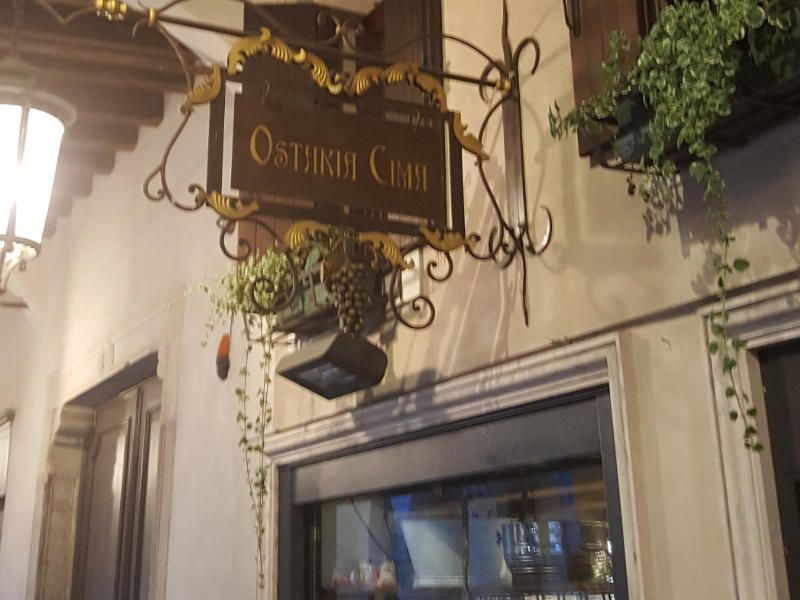
We drove through Valdobbiadene, soaking in the scenery, and stopped a little further along for a truly delicious lunch in the heart of the original Prosecco region—Cartizze, in the town of Santo Stefano di Valdobbiadene. Luckily, we snagged a spot at Restaurant Salis, a fantastic little gem perched with a breathtaking view of some of the very best Prosecco vineyards.
Oh—and did I mention it was a surprise for my wife’s birthday? 🙂
After lunch, we headed to Bisol for a tour and Prosecco tasting. This is one of the more famous wineries in the region, and we were treated to a tasting of a whole range of their finest wines. It was educational, fun, and ... let’s be honest- delicious.
Once our glasses were empty (and our hearts full), we continued on to Conegliano. The magic didn’t stop there. The next evening, after a day trip to Venice, we found ourselves in the midst of the Black Run festivities in Conegliano. The whole village had turned out, and in a cozy, welcoming wine bar -Osteria Cima- we raised a final glass, even with the kids in tow, and reflected on two truly unforgettable days.
All in all, it was a perfect introduction to one of Italy’s most famous wines. And yes -I’d love to go back, explore more vineyards, and taste even more of what this sparkling wine region has to offer.
But before we dream about the next trip, it’s time to dive a little deeper into Prosecco itself.
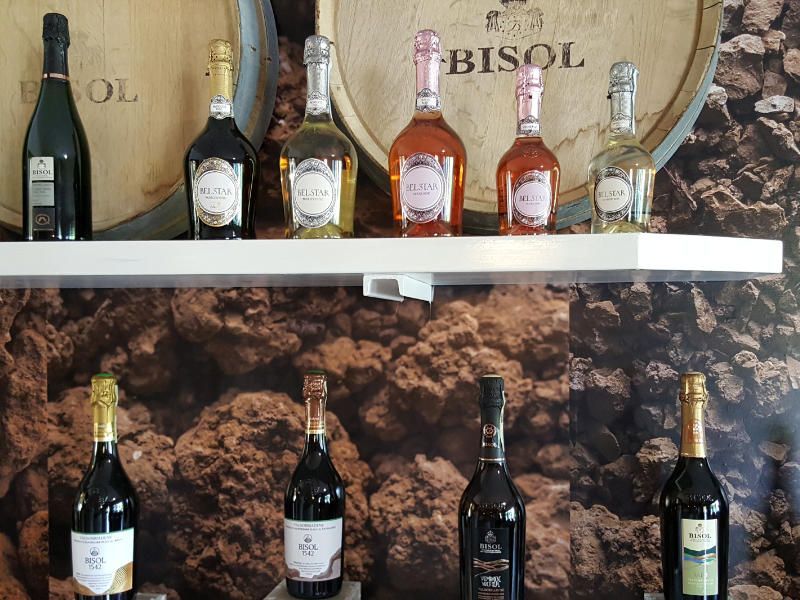
Everything You Ever Wanted to Know About Prosecco
Before we wander through the lively hills of the Prosecco region in Italy, let’s take a quick pit stop to answer the question:
What exactly is Prosecco?
In a nutshell, Prosecco is Italy’s most famous sparkling wine—think of it as the bubbly cousin of Champagne. It’s made from at least 85% Glera grapes and follows the Metodo Martinotti (also called the Charmat method). Unlike French Champagne, the second fermentation happens in a sealed steel tank (an autoclave), not in the bottle. So, you get all that fresh, fruity fizz without the heavy-handed complexity of bottle-fermented Champagne.
Now that we’ve got the basics, we can really dive in.
In the sections below, I’ll take you on a journey through the sparkling world of one of Italy’s most beloved wines. We’ll explore the Prosecco wine region, how this delicious bubbly is made, the different types of Prosecco you can enjoy, and even the best places to get it here in the Netherlands and Belgium. By the end, you’ll have answers to all your Prosecco questions.
If you’re short on time, feel free to jump straight to the chapter that catches your eye. But if you’re ready to savor it like a fine glass of Prosecco, stay with me and let’s explore one of the world’s most famous bubbles together.
Here’s what’s coming up:
- Chapter 1: The Prosecco Wine Region
- Chapter 2: How Prosecco is Made
- Chapter 3: What Types of Prosecco Are There?
- Chapter 4: The Enchanting Prosecco Wine Routes
The Prosecco Wine Region
Prosecco comes from the beautiful northeastern corner of Italy, where the vines have been thriving for over 200 years. This is the land where the Prosecco grape—Glera—found its perfect home, and where sparkling wine has been lovingly crafted for generations.
At the heart of it all, producing the very finest Prosecco DOCG, is the Veneto region. Here, five provinces—Belluno, Padua, Treviso, Venice, and Vicenza—take center stage in making this celebrated bubbly. Just next door, in the Friuli-Venezia Giulia region, four more provinces—Gorizia, Pordenone, Trieste, and Udine—also contribute to Prosecco’s sparkling fame.
So what makes this area so special? It’s a perfect mix of land, sun, and climate. The steep, rolling hills are ideal for the Glera vines, and the swings in temperature between day and night help the grapes develop the delicate flavors and natural freshness that make Prosecco so irresistible.
In short: the hills, the climate, and the centuries of experience all come together here to create a sparkling wine that’s truly magical.
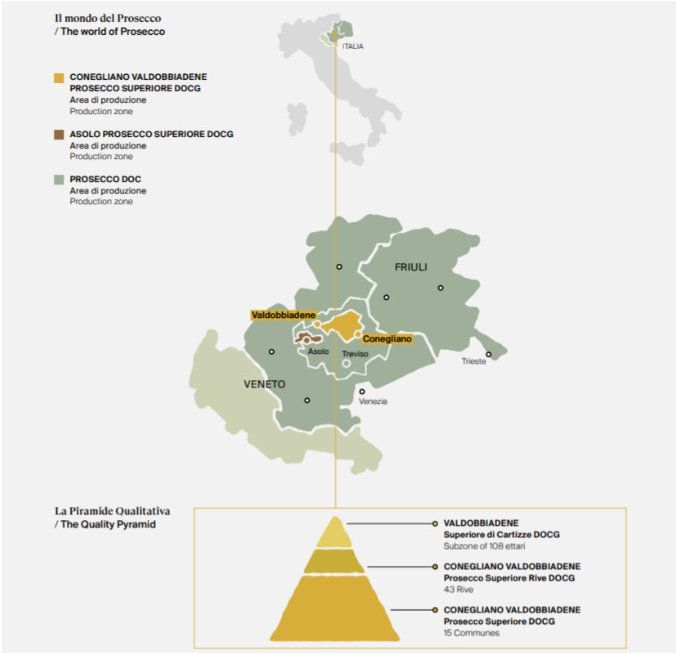
Understanding the Different Types of Prosecco
By now, you probably have a sense that Prosecco isn’t just one thing—there’s a whole world of labels and classifications behind this sparkling wine. Broadly speaking, Prosecco comes in two main categories: Prosecco DOCG and Prosecco DOC.
The DOCG wines—the top-tier Prosecco—mostly come from Conegliano-Valdobbiadene, which is essentially the birthplace of all Prosecco. A little southwest of this area, around Asolo, lies the second DOCG zone. DOC wines, on the other hand, come from a much larger area.
Within these categories, there are even more variations, tied to geography, vineyard quality, and production rules. For instance, in the
Conegliano-Valdobbiadene DOCG region, there are two especially notable sub-zones: Cartizze and 43 so-called Rives.
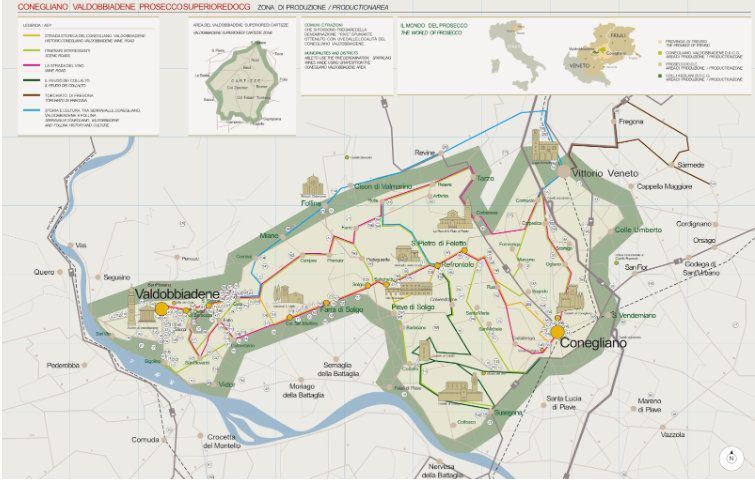
Prosecco from Cartizze
If you’re hunting for the very best Prosecco, Cartizze is the place to look. Nestled right in the heart of the Conegliano-Valdobbiadene DOCG region, this area produces only Spumante wines (fully sparkling), and the quality is exceptional.
Prosecco Rives
Beyond Cartizze, there are 43 “Rive” areas. The word Rive simply means hillside or mountainside in Italian, and it’s a nod to the steep, sun-drenched slopes where the Glera grapes thrive. The Conegliano-Valdobbiadene consortium picked these 43 areas because the conditions—steep hills, ideal sun, and big day-night temperature swings—create grapes of exceptional quality.
A Prosecco Superiore can carry the Rive name if it meets strict rules:
- Grapes must come exclusively from a designated Rive area
- The wine must be Spumante (fully sparkling, over 3 bars of pressure—no Frizzante or semi-sparkling allowed)
- Yields per hectare are lower than standard DOCG regulations, ensuring extra concentration and flavor
These rules, though relatively new, guarantee that a Rive-labeled Prosecco is top quality.
The full list of all 43 Rive areas is extensive, covering 12 municipalities and 31 smaller local zones, including names like Arfanta, Bigolino, Col San Martino, Farra di Soligo, Miane, Santo Stefano, and many more.
Now that we know where Prosecco comes from and what makes certain bottles extra special, it’s time to explore how this sparkling magic is made -from grape to glass.
How Prosecco Is Made
We already touched on this briefly earlier, but let’s dive a little deeper into how Prosecco gets its signature sparkle.
At its core, Prosecco is made from at least 85% Glera grapes and follows the Metodo Martinotti, also known as the Charmat method. In this process, the second fermentation -the magical moment when the bubbles are born- takes place in a sealed stainless steel tank (called an autoclave), rather than inside the bottle like Champagne (that’s the Metodo Classico).
There is, however, a lovely exception: a small, traditional style called Prosecco Col Fondo. It represents just a tiny fraction of total production—less than 1% (about 252,000 bottles out of 355 million, according to 2015 figures). In this version, the second fermentation happens in the bottle, just as it did in the old days. But more on that in a bit.
From Vine to Wine
The story of Prosecco begins just like any other wine:
- The vines are pruned in winter, resting before a new cycle begins.
- In spring, tiny flowers appear and start forming grapes.
- During summer, the grapes ripen under the Italian sun.
- And in autumn, it’s harvest time—the moment winemakers wait for all year.
After harvesting, the grapes are pressed gently, and the juice begins its first fermentation. Here, the natural sugars turn into alcohol and carbon dioxide. The CO₂ escapes, leaving behind a still (non-sparkling) base wine. This stage usually takes about two weeks.
Metodo Martinotti (or Charmat Method)
Now comes the fun part: the bubbles!
For Prosecco, a second fermentation is what creates that beautiful fizz. Winemakers add a blend of sugar and yeast (called the tirage) to the base wine, which triggers another round of fermentation inside those sealed tanks. The CO₂ this time can’t escape, so it dissolves into the wine, creating the gentle sparkle we all love.
After a few months of resting (around three, on average), the wine is filtered and a touch of sweetness is adjusted with a mixture of sugar and grape must, known as the dosage. This determines how sweet or dry the final Prosecco will be—Brut, Extra Dry, or Dry.
Once that’s done, it’s bottled, sealed, and ready to pop!
Prosecco Col Fondo
Now, let’s go back to that charming old-world version: Prosecco Col Fondo.
This style is a nod to how Prosecco was made long before modern tank technology existed. Here, the second fermentation happens inside the bottle itself. The process starts the same way as Champagne: the base wine is bottled with sugar and yeast to kick off fermentation.
But here’s the twist—there’s no disgorgement (the process of freezing the bottle neck and removing the yeast sediment). Instead, the sediment remains in the bottle, giving the wine its name: Col Fondo, meaning “with sediment.”
No extra sugar is added, so the result is a drier, more rustic Prosecco with a slightly cloudy look and a naturally complex flavor. It’s usually aged for around six months before it’s released -a beautiful throwback to the original Prosecco of generations past.
So next time you pour yourself a glass of bubbly, you’ll know exactly where those tiny, joyful bubbles came from -and maybe even which kind of Prosecco you’re sipping.
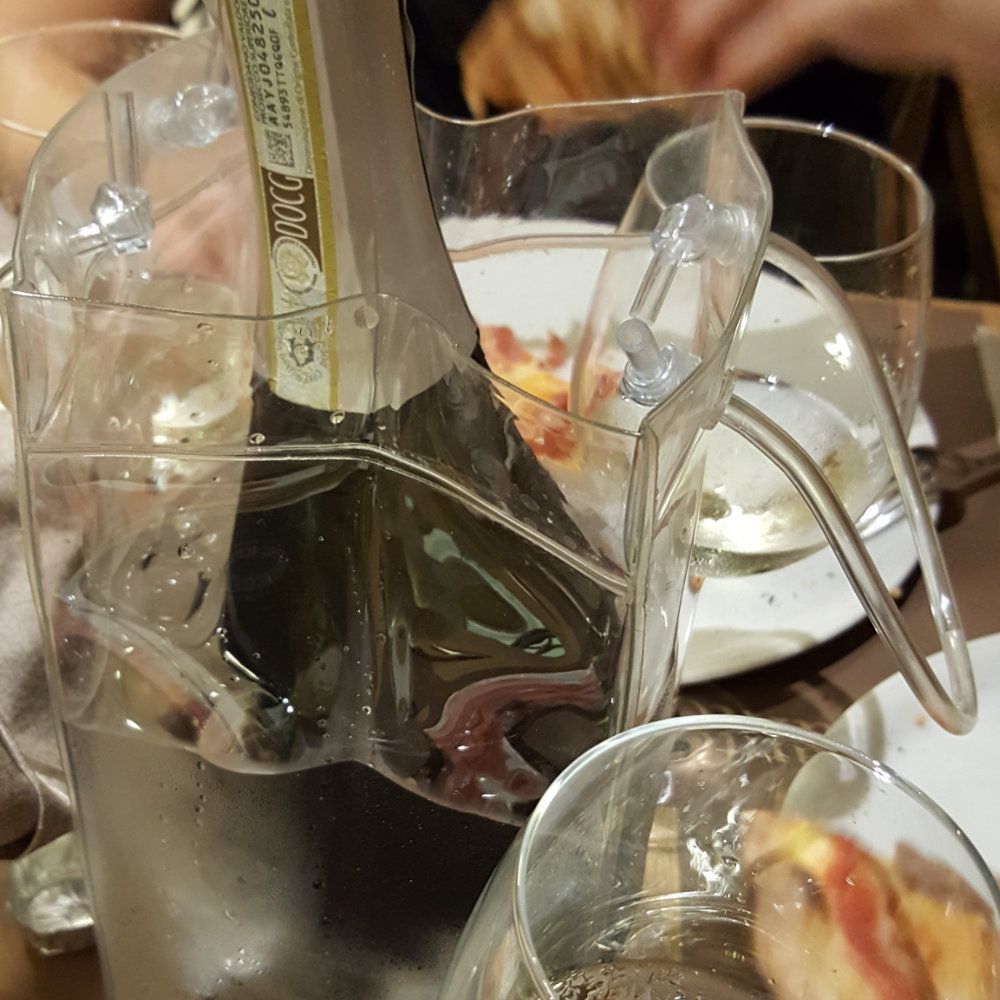
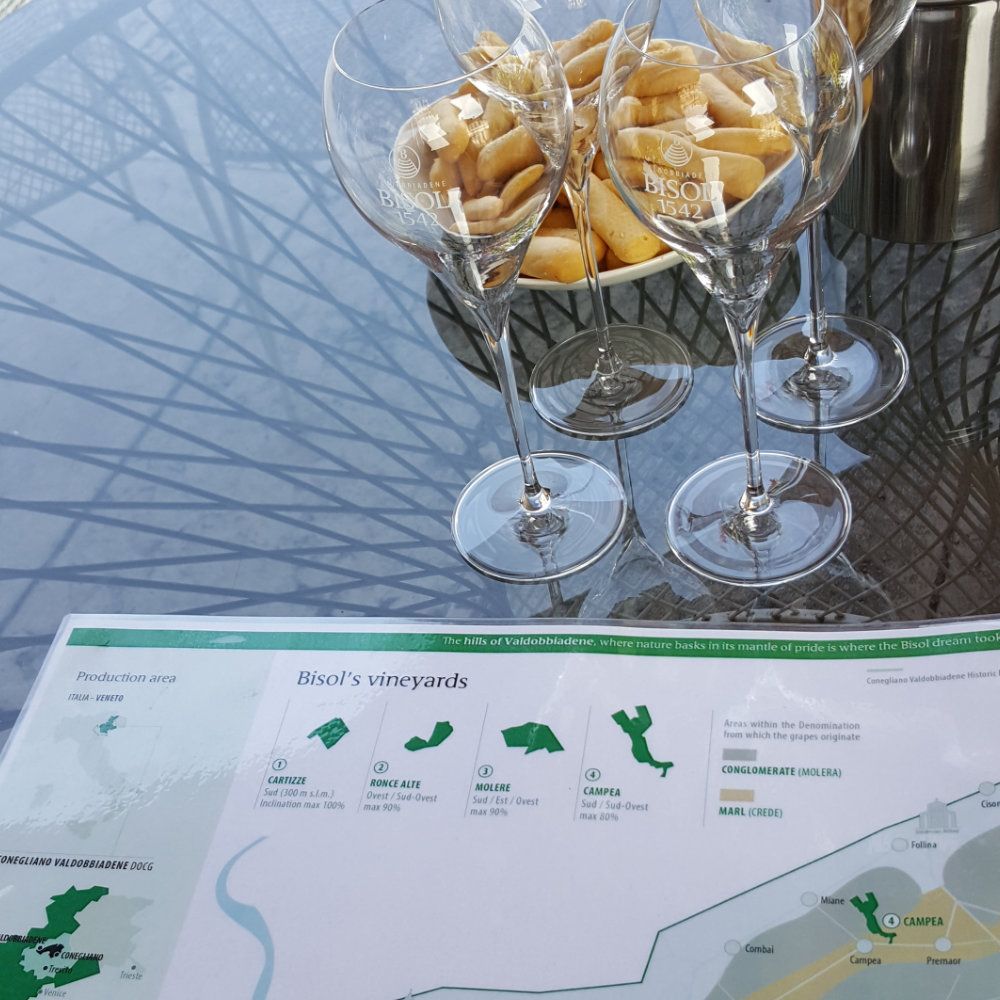
What Types of Prosecco Are There?
There’s a whole sparkling world of Prosecco out there—and not all bottles are created equal. When we talk about the types of Prosecco, we’re really talking about a few different things:
- The quality level (DOCG, DOC, etc.)
- The production method
- The region of origin
- The sweetness level
- And even how bubbly the wine is
Let’s take a little tour through these variations so you’ll know exactly what you’re uncorking next time.
Prosecco by Quality and Origin
If you were to ask wine experts to rank Prosecco by quality, the list would look something like this (though, of course, the best one is always the one you enjoy most):
- Valdobbiadene Superiore di Cartizze DOCG
- Conegliano Valdobbiadene Prosecco Superiore Rive DOCG
- Asolo Prosecco Superiore DOCG
- Conegliano Valdobbiadene Prosecco Superiore DOCG
Prosecco lovers often look to the Italian quality designations—DOCG, DOC, and IGT—to get a sense of origin and craftsmanship. Here’s how they stack up:
- Conegliano Valdobbiadene Prosecco DOCG
- Valdobbiadene Superiore di Cartizze DOCG
- Conegliano Valdobbiadene Prosecco Superiore Rive DOCG
- Conegliano Valdobbiadene Prosecco Superiore DOCG
- Asolo Prosecco DOCG / Asolo Prosecco Superiore DOCG / Asolo Prosecco Superiore Col Fondo DOCG
- Prosecco DOC, including the Treviso and Trieste subzones
The DOCG wines come from the original, most prized Prosecco region—between Valdobbiadene (on the west) and Conegliano (on the east). Experts agree that the very best wines come from Cartizze, often called the “Grand Cru” of Prosecco.
Next are the Rive DOCG wines, produced in 43 designated hillside areas known for their exceptional grapes. Then come the Superiore DOCG wines from Asolo and Conegliano Valdobbiadene that lie outside the Rive zones.
Finally, there are the DOC Proseccos, grown across a wider area. The best of these come from the Treviso and Trieste subzones.
Differences in Production
As we explored in the last chapter, almost all Prosecco is made using the Metodo Martinotti (or Charmat method)—the second fermentation happens in stainless steel tanks.
A small exception exists in the Asolo region, where a handful of winemakers still craft Prosecco Col Fondo, made the old-fashioned way with the second fermentation in the bottle. It’s cloudy, rustic, and wonderfully authentic.
Differences in Sweetness: Brut, Extra Dry, or Dry
The sweetness level plays a huge role in how a Prosecco tastes. After the second fermentation, just before bottling, winemakers add a touch of sugar (dosage). The amount determines whether the wine is labeled Brut, Extra Dry, or Dry—and here’s where it gets a little tricky:
“Dry” Prosecco is actually the sweetest! Confusing, right?
Here’s the full sweetness scale, from driest to sweetest:
- Zero Dosage / Nature (the driest)
- Extra Brut
- Brut
- Extra Dry
- Dry
- Demi Sec (the sweetest)
Let’s break down the three you’ll most often see:
Prosecco Dry: Despite the name, it’s the sweetest style, with 17–32 grams of sugar per liter.
Prosecco Extra Dry: The classic, most common version in Italy—pleasantly balanced, with 12–17 grams of sugar per liter.
Prosecco Brut: The driest and most modern style, made largely for export, with under 12 grams of sugar per liter—closest in taste to Champagne.
Spumante or Frizzante: The Sparkle Factor
Finally, not all Proseccos have the same level of bubbles. The two main types are:
- Spumante - Fully sparkling, with a bottle pressure of 3–5 bars. This is the most common and elegant version, made with the best Glera grapes.
- Frizzante - Lightly sparkling, with gentler bubbles and a pressure under 3 bars. It’s softer and more casual—perfect for easy summer sipping.
So, whether you prefer your Prosecco bold and bubbly, soft and slightly sweet, or dry and crisp, there’s a style out there that fits your taste perfectly. That’s part of what makes Prosecco so irresistible—there’s a version for every mood, every occasion, and every glass.
The Enchanting Prosecco Wine Routes
If you really want to experience the world of Prosecco, there’s no better way than to follow the official wine routes that wind through the rolling hills, sleepy villages, and sunlit vineyards of northeastern Italy. There are two main routes to choose from—each offering its own charm, character, and, of course, plenty of opportunities to sip some sparkling perfection along the way:
- Strada del Prosecco e Vini dei Colli Conegliano Valdobbiadene
- Strada del Vino del Montello e Colli Asolani
Strada del Prosecco e Vini dei Colli Conegliano Valdobbiadene
This is the classic Prosecco route—the most famous, the most scenic, and the one every Prosecco lover dreams of driving one day. It winds through the heart of the original Prosecco region, where some of the finest DOCG wines are made.
It’s no coincidence that part of this area was added to the UNESCO World Heritage List in 2019. The landscape is breathtaking: gentle green hills lined with perfectly kept vines, charming villages perched on hilltops, and family-run wineries that have been producing sparkling wine for generations.
The route stretches for about 50 kilometers, starting in Valdobbiadene and passing through San Stefano, Campea, Colbertaldo, Farra di Soligo, and San Pietro di Feletto, before reaching Conegliano. Of course, you can easily drive it in the opposite direction too—it’s beautiful either way.
How long the journey takes really depends on you—your pace, your curiosity, and how many times you stop to taste a glass (or two) of bubbly. Whether you do it by car, e-bike, or even on foot in certain stretches, it’s an unforgettable experience.
Fun fact: this route was actually Italy’s very first official wine road, established all the way back in 1966! And yes, there’s even a dedicated website for it, packed with maps, wineries, and tips for planning your own sparkling adventure.
Strada del Vino del Montello e Colli Asolani
The second route lies a little further south, in the Asolo Prosecco DOCG region. This area is less touristy and a bit more off the beaten path, which makes it perfect for travelers who love discovering hidden gems.
Along the Strada del Vino del Montello e Colli Asolani, you’ll find not only Prosecco but also other delicious wines from the Asolo hills—each with its own distinct character and story. It’s a quieter, slower route where you can truly soak up the rhythm of Italian country life.
If you’d like to explore even further, the Avinturo website offers a wonderful overview of nearly 100 official wine routes across Italy—each one waiting to be explored, glass in hand.
So whether you follow the iconic Conegliano-Valdobbiadene trail or the serene hills of Asolo, one thing’s for sure: every twist and turn of these routes will leave you with a deeper appreciation for Prosecco—and maybe even a new favorite bottle to take home.
Sources and Inspiration
Of course, much of what I’ve shared comes from our own experiences exploring the Prosecco region. But I also did a fair bit of digging around online to gather even more background and helpful information.
To make it easy for you to keep exploring the world of Prosecco yourself, I’ve put together a handy list of the best websites, blogs, and official pages. And if you know of a great one I’ve missed, please do let me know!
Consortia of Winemakers
Consortium of Conegliano Valdobbiadene Prosecco DOCG Winemakers
Consortium of, among others, Asolo Prosecco DOCG Winemakers
Consortium of Prosecco DOC Winemakers
The official Prosecco Wine Roads
Strada del Prosecco e Vini dei Colli Conegliano Valdobbiadene
Strada del Vino del Montello e Colli Asolani
Other Wine Websites and Blogs
Tourism Websites
Official Website of Valdobbiadene
Official Website of Conegliano
Happy Prosecco tastings 🙂